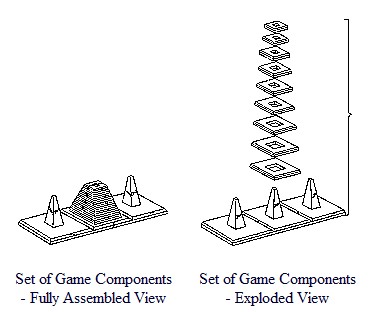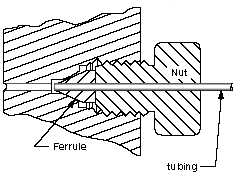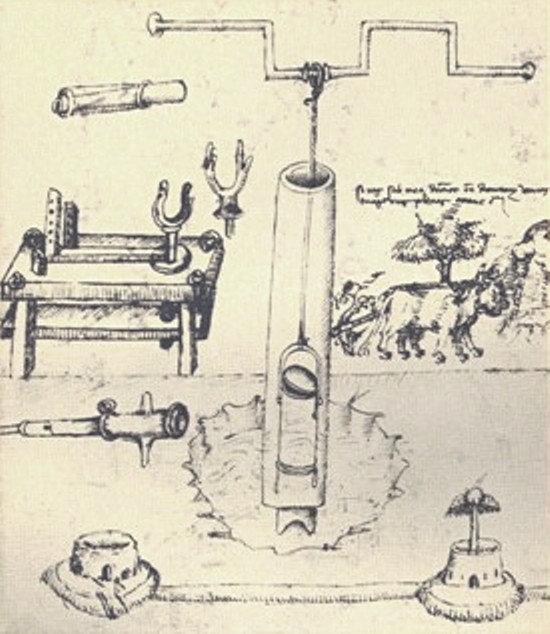|
Exploded-view Drawing
An exploded-view drawing is a diagram, picture, schematic or technical drawing of an object, that shows the relationship or order of assembly of various parts. It shows the components of an object slightly separated by distance, or suspended in surrounding space in the case of a three-dimensional exploded diagram. An object is represented as if there had been a small controlled explosion emanating from the middle of the object, causing the object's parts to be separated an equal distance away from their original locations. The exploded-view drawing is used in parts catalogs, assembly and maintenance manuals and other instructional material. The projection of an exploded view is usually shown from above and slightly in diagonal from the left or right side of the drawing. (See exploded-view drawing of a gear pump to the right: it is slightly from above and shown from the left side of the drawing in diagonal.) Overview An exploded-view drawing is a type of drawing, that sh ... [...More Info...] [...Related Items...] OR: [Wikipedia] [Google] [Baidu] |
Gear Pump Exploded
A gear or gearwheel is a rotating machine element, machine part typically used to transmit rotation, rotational motion and/or torque by means of a series of teeth that engage with compatible teeth of another gear or other part. The teeth can be integral saliences or cavities machining, machined on the part, or separate pegs inserted into it. In the latter case, the gear is usually called a cogwheel. A cog may be one of those pegsDefinition of "cog" in the ''Oxford Learner's Dictionary'' online. Accessed on 2024-07-29.Definition of "cog" in the ''Merriam-Webster Dictionary'' online. Accessed on 2024-07-29. [...More Info...] [...Related Items...] OR: [Wikipedia] [Google] [Baidu] |
Architectural Plan
In architecture and building engineering, a floor plan is a technical drawing to scale, showing a view from above, of the relationships between rooms, spaces, traffic patterns, and other physical features at one level of a structure. Dimensions are usually drawn between the walls to specify room sizes and wall lengths. Floor plans may also include details of fixtures like sinks, water heaters, furnaces, etc. Floor plans may include notes for construction to specify finishes, construction methods, or symbols for electrical items. It is also called a ''plan'' which is a measured plane typically projected at the floor height of , as opposed to an ''elevation'' which is a measured plane projected from the side of a building, along its height, or a section or '' cross section'' where a building is cut along an axis to reveal the interior structure. Overview Similar to a map, the orientation of the view is downward from above, but unlike a conventional map, a plan is drawn at a pa ... [...More Info...] [...Related Items...] OR: [Wikipedia] [Google] [Baidu] |
Perspective (graphical)
Linear or point-projection perspective () is one of two types of graphical projection perspective in the graphic arts; the other is parallel projection. Linear perspective is an approximate representation, generally on a flat surface, of an image as it is seen by the eye. Perspective drawing is useful for representing a three-dimensional scene in a two-dimensional medium, like paper. It is based on the optical fact that for a person an object looks N times (linearly) smaller if it has been moved N times further from the eye than the original distance was. The most characteristic features of linear perspective are that objects appear smaller as their distance from the observer increases, and that they are subject to , meaning that an object's dimensions parallel to the line of sight appear shorter than its dimensions perpendicular to the line of sight. All objects will recede to points in the distance, usually along the horizon line, but also above and below the horiz ... [...More Info...] [...Related Items...] OR: [Wikipedia] [Google] [Baidu] |
Cutaway (industrial)
A cutaway, in the industrial sense, refers to the display of a manufactured product, (an engine, a pump, a regulator, etc.) where a portion of the exterior housing has been removed to reveal the internal components, (pistons, bearings, seals, etc.) and their relationship to the functionality of the product. Cutaways are typically used in product training, trade show environments, museum displays and for many additional applications. Cutaways are produced using a variety of methods by the manufacturer, by a cutaway service company, as mentioned above, or by an experienced machine shop. While 3D modeling and CAD (computer-aided drafting) programs continue to improve and bring more features and benefits, the cutaway will continue to show the product as it appears in the real world, using actual parts and components to show relationships and functionality. Bauma 2007 ZF Loader Axle MT-L3075 2.jpg, Cutaway of a limited-slip differential manufactured by ZF Audi R8 cutaway (2305471 ... [...More Info...] [...Related Items...] OR: [Wikipedia] [Google] [Baidu] |
Cutaway Drawing
A cutaway drawing, also called a cutaway diagram, is a 3D graphics, drawing, diagram and or illustration, in which surface elements of a three-dimensional model are selectively removed, to make internal features visible, but without sacrificing the outer context entirely. Overview According to Diepstraten et al. (2003), "the purpose of a cutaway drawing is to allow the viewer to have a look into an otherwise solid opaque object. Instead of letting the inner object shine through the surrounding surface, parts of outside object are simply removed. This produces a visual appearance as if someone had cutout a piece of the object or sliced it into parts. Cutaway illustrations avoid ambiguities with respect to spatial ordering, provide a sharp contrast between foreground and background objects, and facilitate a good understanding of spatial ordering".J. Diepstraten, D. Weiskopf & T. Ertl (2003)"Interactive Cutaway Illustrations". in: ''Eurographics 2003''. P. Brunet and D. Fellner (ed ... [...More Info...] [...Related Items...] OR: [Wikipedia] [Google] [Baidu] |
Cross Section (geometry)
In geometry and science, a cross section is the non-empty intersection (set theory), intersection of a solid body in three-dimensional space with a Plane (geometry), plane, or the analog in higher-dimensional spaces. Cutting an object into slices creates many parallel cross-sections. The boundary of a cross-section in three-dimensional space that is parallel to two of the Cartesian coordinate system, axes, that is, parallel to the plane determined by these axes, is sometimes referred to as a contour line; for example, if a plane cuts through mountains of a raised-relief map parallel to the ground, the result is a contour line in two-dimensional space showing points on the surface of the mountains of equal elevation. In technical drawing a cross-section, being a Planar projection, projection of an object onto a plane that intersects it, is a common tool used to depict the internal arrangement of a 3-dimensional object in two dimensions. It is traditionally crosshatched with th ... [...More Info...] [...Related Items...] OR: [Wikipedia] [Google] [Baidu] |
Reciprocating Motion
Reciprocating motion, also called reciprocation, is a repetitive up-and-down or back-and-forth linear motion. It is found in a wide range of mechanisms, including reciprocating engines and pumps. The two opposite motions that comprise a single reciprocation cycle are called strokes. A crank can be used to convert into reciprocating motion, or conversely turn reciprocating motion into circular motion. For example, inside an internal combustion engine (a type of reciprocating engine), the expansion of burning fuel in the cylinders periodically pushes the piston down, which, through the connecting rod, turns the crankshaft. The continuing rotation of the crankshaft drives the piston back up, ready for the next cycle. The piston moves in a reciprocating motion, which is converted into the circular motion of the crankshaft, which ultimately propels the vehicle or does other useful work. The reciprocating motion of a pump piston is close to but different from, sinusoidal A ... [...More Info...] [...Related Items...] OR: [Wikipedia] [Google] [Baidu] |
Leonardo Da Vinci
Leonardo di ser Piero da Vinci (15 April 1452 - 2 May 1519) was an Italian polymath of the High Renaissance who was active as a painter, draughtsman, engineer, scientist, theorist, sculptor, and architect. While his fame initially rested on his achievements as a painter, he has also become known for #Journals and notes, his notebooks, in which he made drawings and notes on a variety of subjects, including anatomy, astronomy, botany, cartography, painting, and palaeontology. Leonardo is widely regarded to have been a genius who epitomised the Renaissance humanism, Renaissance humanist ideal, and his List of works by Leonardo da Vinci, collective works comprise a contribution to later generations of artists matched only by that of his younger contemporary Michelangelo. Born out of wedlock to a successful notary and a lower-class woman in, or near, Vinci, Tuscany, Vinci, he was educated in Florence by the Italian painter and sculptor Andrea del Verrocchio. He began his career ... [...More Info...] [...Related Items...] OR: [Wikipedia] [Google] [Baidu] |
Francesco Di Giorgio
Francesco di Giorgio Martini (1439–1501) was an Italian architect, engineer, painter, sculptor, and writer. As a painter, he belonged to the Sienese School. He was considered a visionary architectural theorist—in Nikolaus Pevsner's terms: "one of the most interesting later Quattrocento architects". As a military engineer, he executed architectural designs and sculptural projects and built almost seventy fortifications for the Federico da Montefeltro, Count (later Duke) of Urbino, building city walls and early examples of star-shaped fortifications. Born in Siena, he apprenticed as a painter with Vecchietta. In panels painted for '' cassoni'' he departed from the traditional representations of joyful wedding processions in frieze-like formulas to express visions of ideal, symmetrical, vast and all but empty urban spaces rendered in perspective. He composed an architectural treatis''Trattato di architettura, ingegneria e arte militare'' the third of the Quattrocento, ... [...More Info...] [...Related Items...] OR: [Wikipedia] [Google] [Baidu] |
Taccola
Mariano di Jacopo (1382 – c. 1453), called Taccola (" the jackdaw"), was an Italian polymath, administrator, artist and engineer of the early Renaissance. Taccola is known for his technological treatises ''De ingeneis'' and ''De machinis'', which feature annotated drawings of a wide array of innovative machines and devices. Taccola's work was widely studied and copied by later Renaissance engineers and artists, among them Francesco di Giorgio, and Leonardo da Vinci. Life and career Mariano Taccola was born in Siena in 1382. Practically nothing is known of his early years of training or apprenticeship.Fane, p.136 As an adult, he pursued a varied career in Siena, working in such diverse jobs as notary, university secretary, sculptor, superintendent of roads and hydraulic engineer. Notably, he created a series of woodcarvings for the Duomo, a cathedral in Florence in June 26, 1408. Taccola married a woman named Madonna Nanna, likely around 1420, and had a daughter named Alba in ... [...More Info...] [...Related Items...] OR: [Wikipedia] [Google] [Baidu] |
Renaissance
The Renaissance ( , ) is a Periodization, period of history and a European cultural movement covering the 15th and 16th centuries. It marked the transition from the Middle Ages to modernity and was characterized by an effort to revive and surpass the ideas and achievements of classical antiquity. Associated with great social change in most fields and disciplines, including Renaissance art, art, Renaissance architecture, architecture, politics, Renaissance literature, literature, Renaissance exploration, exploration and Science in the Renaissance, science, the Renaissance was first centered in the Republic of Florence, then spread to the Italian Renaissance, rest of Italy and later throughout Europe. The term ''rinascita'' ("rebirth") first appeared in ''Lives of the Artists'' () by Giorgio Vasari, while the corresponding French word was adopted into English as the term for this period during the 1830s. The Renaissance's intellectual basis was founded in its version of Renaiss ... [...More Info...] [...Related Items...] OR: [Wikipedia] [Google] [Baidu] |







